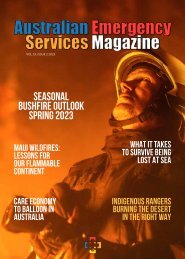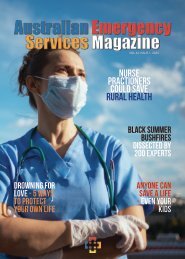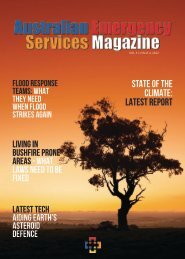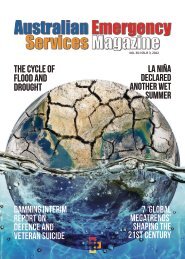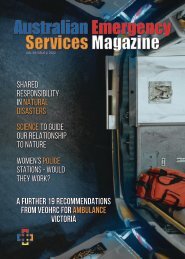Vol. 10 Issue 5. 2018
The Australian Emergency Services Magazine is a community educational resource dedicated to the recognition and promotion of emergency service personnel, and the awareness of safety measures, for the community, family and individual. We aim to provide relevant and up to date information and advancements within each of the emergency response sectors and first responders.
The Australian Emergency Services Magazine is a community educational resource dedicated to the recognition and promotion of emergency service personnel, and the awareness of safety measures, for the community, family and individual. We aim to provide relevant and up to date information and advancements within each of the emergency response sectors and first responders.
You also want an ePaper? Increase the reach of your titles
YUMPU automatically turns print PDFs into web optimized ePapers that Google loves.
Nov - Dec <strong>2018</strong> <strong>Vol</strong> <strong>10</strong><br />
Climate Change<br />
and our National<br />
Security<br />
Surveillance<br />
Helps the<br />
Homeless<br />
El Nino Alert<br />
A Long Hot Summer Ahead
IF IT DOESN’T ADD UP,<br />
SPEAK UP.<br />
CALL THE<br />
NATIONAL SECURITY HOTLINE<br />
1800 123 400<br />
Even if you think it’s probably nothing, the smallest piece of information<br />
can be valuable. Calls to the National Security Hotline have already<br />
contributed to investigations. If something doesn’t add up, speak up<br />
by calling the National Security Hotline.<br />
Authorised by the Australian Government, Capital Hill, Canberra.
CONTENTS<br />
Editor’s Note<br />
2<br />
Latest Events<br />
Black Hawk Helicopter - Shutterstock<br />
• Red25 Emergency Services<br />
Challenge Winners<br />
• Resilient Australia Awards<br />
• ESTA wins Risk & Resilience<br />
Award<br />
Drought Follow-up<br />
El Nino Alert<br />
Prepare for Bushfire Season<br />
ACT Bushfire Tool<br />
Climate Change and our National<br />
Security<br />
When to call 000<br />
Cyclist Road Toll - Drivers at Fault<br />
Emergency Contact Information<br />
Surveillance Helps the Homeless<br />
Copycat Crimes<br />
3<br />
4<br />
5<br />
8<br />
<strong>10</strong><br />
12<br />
14<br />
18<br />
23<br />
26<br />
29<br />
30<br />
33<br />
DISCLAIMER<br />
The Australian Emergency Services Magazine is a community<br />
educational resource and does not promote itself as a charity or fund<br />
raising institution, nor solicit on behalf of charities and is no way<br />
financially supported by or associated with any government or similar<br />
institution. Distributions of the publication is Bi-Monthly and are<br />
circulated via a database of interested parties, including business,<br />
subscribers, advertisers, volunteer emergency organistations, and<br />
council libraries. A digital eMag is distributed to a targeted database<br />
in each State & Territory. All information published in the Australian<br />
Emergency Services Magazine is in good faith and whilst every effort<br />
is made to ensure that the publication is free of error and omission, no<br />
responsibility or liability will be accepted by Boothbook Pty Ltd.<br />
www.aesj.com.au<br />
MAGAZINE CONTACTS<br />
1300 851 7<strong>10</strong><br />
press@aesj.com.au<br />
Published by Boothbook Media<br />
ABN:72 605 987 031<br />
1<br />
Suite 112, Locked Bag 1<br />
Robina TC, QLD 4230
EDITORS NOTE<br />
It’s almost Summer<br />
Welcome to another edition of the<br />
Australian Emergency Services<br />
Magazine. There is so much going<br />
on in this sector at this time of<br />
year it is hard to keep up with it<br />
all.<br />
As we lead into the Summer in<br />
Australia we know how fraught<br />
this season is with the potential<br />
for different natural disasters.<br />
From bushfires, summer storms,<br />
flooding and cyclone season, and<br />
of course the continuing drought.<br />
Along with this it is the season for<br />
summer holidays, family and work<br />
celebrations.<br />
The reliance on our emergency<br />
services agencies and personnel<br />
becomes greater over this summer<br />
season and it seems the season is<br />
getting longer every year. As we<br />
saw last year, cyclone season was<br />
having an impact right up to the<br />
end of April.<br />
The prediction of a long hot<br />
summer from the Bureau of<br />
Meteorology and an El Nino alert<br />
doesn’t bring much relief for our<br />
farmers, nor does it ease concerns<br />
for potential bushfires over the<br />
course of the summer.<br />
Information about the El Nino<br />
alert can be found in our article<br />
from the Bureau of Meteorology.<br />
There is also some great news<br />
when it comes to battling<br />
bushfires. In an Australian first,<br />
the ACT Emergency Services<br />
2<br />
Agency (ESA) has developed a<br />
first of its kind Auto Bushfire<br />
Attack Level (BAL) Tool, in<br />
partnership with, Esri Australia,<br />
a leading GIS technology firm.<br />
The tool was launched at the<br />
AFAC in Perth in early September.<br />
This tool has the potential to be<br />
groundbreaking when it comes to<br />
bushfire preparedness.<br />
From all of us at The Australian<br />
Emergency Services Magazine,<br />
have a wonderful Christmas with<br />
your family and stay safe,<br />
Until next year, happy reading,<br />
Emma Parker<br />
Editor
LATEST EVENTS<br />
Who took the title in <strong>2018</strong>?<br />
The Red25 Emergency Services<br />
Challenge <strong>2018</strong> has now wrapped.<br />
Thank you to all of the generous<br />
people who gave blood during the<br />
challenge.<br />
In 12 short weeks, personnel from<br />
Emergency Service organisations<br />
across the country gave a total of<br />
<strong>10</strong>,656 donations, saving up to 31,968<br />
lives!<br />
The results show that a little healthy<br />
competition goes a long way.<br />
On behalf of Australian patients,<br />
thank you!<br />
The challenge is over, but the need<br />
remains.<br />
Although it’s fun to have a short<br />
competition, the need for blood is<br />
year-round. Register to your Red25<br />
group and donate regularly. As a<br />
member, your donations will count<br />
towards your group’s annual tally year<br />
round.<br />
www.donateblood.com.au<br />
Award Winners<br />
Highest number of donations made by a Red25 group in their state of origin<br />
STATE ORGANISATION DONATIONS<br />
VIC Victoria Police 1246<br />
NSW NSW Police Force 1115<br />
QLD QLD Police Service 674<br />
SA South Australia Police (SAPOL) 574<br />
WA St John Ambulance WA 299<br />
TAS Tasmania Police 203<br />
ACT Australian Federal Police (AFP) 194<br />
NT NT Police Fire and Emergency Service (PFES) 89<br />
Highest year on year growth<br />
ORGANISATION<br />
NT Police Fire and Emergency Services (PFES) 225%<br />
Highest number of donors vs Red25 members<br />
(Must have a minimum of 20 members)<br />
ORGANISATION<br />
NT Fire and Rescue 56.5%<br />
Highest number of new donors<br />
(Must have a minimum of 20 members)<br />
ORGANISATION<br />
Victoria Police 128<br />
PERCENTAGE<br />
PERCENTAGE<br />
NEW DONORS<br />
3
LATEST EVENTS<br />
Jurisdictional winners<br />
announced for <strong>2018</strong> Resilient<br />
Australia Awards<br />
Congratulations to the jurisdictional<br />
finalists of the <strong>2018</strong> Resilient Australia<br />
Awards.<br />
National winners will be announced<br />
at the national ceremony in Brisbane<br />
on November 8.<br />
Government Award<br />
Ambulance Victoria – GoodSAM<br />
Community Responder Project (VIC)<br />
Mineral Resources Tasmania –<br />
Tsunami inundation modelling in<br />
Southeast Tasmania (TAS)<br />
Wollondilly Shire Council – Activate<br />
Wollondilly (NSW)<br />
Business Award<br />
Centre for Disability Research<br />
and Policy, University of Sydney –<br />
PREPARE NSW: Person-Centred<br />
Emergency Preparedness (NSW)<br />
Community Award<br />
Inner Sydney Voice – Building<br />
Disaster Resilience in Social Housing<br />
Communities (NSW)<br />
Unit – truwana patrula nayri (Cape<br />
Barren Island Good Fire) (TAS)<br />
Tathra Surf Life Saving Club – Tathra<br />
Surf Club Bushfire Recovery <strong>2018</strong><br />
(NSW)<br />
Tumbulgum Community Association<br />
– Resilience Post Floods 2017 (NSW)<br />
Western Australian Council of<br />
Social Services – Disaster Resilient<br />
Community Organisations (WA)<br />
School Award<br />
Moreton Bay Regional Council,<br />
Queensland Fire and Emergency<br />
Services and Queensland Police<br />
Service – My Resilient Community<br />
(QLD)<br />
Shire of Cranbrook – ‘Spring into<br />
Preparedness: Family Fire Safety –<br />
Get Prepared’ (WA)<br />
Territory Intelligence and<br />
Coordination Centre – submitted by<br />
Senior Sergeant Dean Elliot (NT)<br />
Wide Bay Regional Organisation of<br />
Councils – Burnett River Catchment<br />
Flood Resilience Strategy (QLD)<br />
Quandamooka Yoolooburrabee<br />
Aboriginal Corporation in<br />
partnership with the Queensland<br />
Reconstruction Authority –<br />
Minjerribah (North Stradbroke<br />
Island) Bushfire Management Plans<br />
(QLD)<br />
Southern Grampians Glenelg Primary<br />
Care Partnership – Balmoral Fire<br />
Connect (VIC)<br />
St John Ambulance – First Aid in<br />
Schools – Remote Indigenous Access<br />
Project (NT)<br />
Tasmania Fire Service Bushfire Risk<br />
4<br />
Dixons Creek Primary School –<br />
Firestick Project (VIC)<br />
Invermay Primary School,<br />
Launceston Big Picture School<br />
and The Holographic Lounge –<br />
Floodscapes (TAS)<br />
Mindarie Primary School –<br />
coordination of the ‘Art of Resilience’<br />
conference (WA)<br />
Warrimoo Public School – Getting<br />
Bushfire Ready at Warrimoo Public<br />
School (NSW)
LATEST EVENTS<br />
ESTA team winning the <strong>2018</strong> Victorian Department of Justice and Regulation – Risk and Resilience Awards.<br />
ESTA WINS RISK AND<br />
RESILIENCE PARTNERSHIP<br />
AWARD<br />
ESTA was nominated and won the<br />
risk and resilience partnership award<br />
for working with other emergency<br />
services agencies and the Bureau of<br />
Meteorology (BOM) on surge event<br />
modelling and management.<br />
Executive Director Operations<br />
Support, Dr Amee Morgans said,<br />
“Winning an award based on our<br />
partnerships reflects ESTA’s leadership<br />
and innovation in the sector.”<br />
The Emergency Services<br />
Telecommunications Authority<br />
(ESTA) provides the critical link<br />
between the Victorian community<br />
and the state’s emergency services.<br />
It provides Victoria’s 24-hour<br />
emergency call-taking and dispatch<br />
services for police, fire, ambulance<br />
and the Victorian State Emergency<br />
Service (VICSES).<br />
A key challenge in service delivery<br />
has been the ability to predict<br />
consequences of storm-based<br />
surge demand. This affects not<br />
only ESTA’s service delivery, but<br />
creates an opportunity to enhance<br />
agency response and sector surge<br />
management. As Dr Morgans stated,<br />
‘Accurate surge demand forecasting<br />
enables ESTA to activate additional<br />
staff earlier, provide notification at<br />
sector level and deliver better services<br />
5<br />
to the community.’<br />
Since July 2017, ESTA has been<br />
investing in improvements to<br />
better forecast surge demand and<br />
its consequences for emergency<br />
services agencies and the Victorian<br />
community.<br />
Improvements have focused on<br />
improving foundational knowledge<br />
beyond service delivery, combining<br />
knowledge and expertise between<br />
agencies and linking to operational<br />
planning across agencies. Initiatives<br />
included, but were not limited to;<br />
• BOM training for ESTA staff,<br />
which focused on thunderstorms
LATEST EVENTS<br />
and severe weather<br />
• combining data and analytics<br />
with other agency partners to<br />
improve consequence prediction<br />
for storm surge<br />
• improvement of ESTAs Critical<br />
Incident Resource Protocols<br />
(CIRP) to extend from weather<br />
only events to include a range<br />
of disaster and surge scenarios<br />
including thunderstorm asthma,<br />
and<br />
• extended hours of the scheduling<br />
team to optimise multi-agency<br />
trained staff to respond to storm<br />
based surge<br />
ESTA now has access and the<br />
ability to interpret a range of new<br />
BOM reports and translate this into<br />
forecasting triple zero demand for<br />
each emergency service.<br />
A huge congratulations to the ESTA<br />
team on winning such an award<br />
and improving the emergency<br />
response outcomes for the Victorian<br />
community. Along with BOM and<br />
other emergency service agencies,<br />
the win is a great reflection of the<br />
incredible work they do each and<br />
every day for those in need.<br />
6
Drought Follow-up<br />
We must look past shortterm<br />
drought solutions and<br />
improve the land itself<br />
With drought ravaging<br />
Australia’s eastern states,<br />
much attention has been<br />
given to the need to provide shortterm<br />
solutions through drought relief.<br />
But long-term resilience is a vital<br />
issue, particularly as climate change<br />
adds further pressure to farmers and<br />
farmland.<br />
Our research has found that helping<br />
farmers improve the rivers, dams,<br />
native vegetation and trees on their<br />
land increases productivity, the<br />
resilience of the land to drought, and<br />
through this the health and wellbeing<br />
of farmers.<br />
Now is the time to invest more<br />
8<br />
heavily than ever in vital networks in<br />
regional Australia, such as Landcare<br />
and natural resource management<br />
groups like Local Land Services and<br />
Catchment Management Authorities.<br />
Growing pressures on agricultural<br />
land<br />
Some researchers suggest that up
Drought Follow-up<br />
to 370 million hectares of land in<br />
Australia and the Pacific is degraded.<br />
This diminished productivity across<br />
such a large area has significant<br />
implications for the long-term<br />
sustainability of agricultural<br />
production.<br />
Australia also has one of the<br />
worst records for wildlife diversity<br />
loss, including extensive loss of<br />
biodiversity across much of our<br />
agricultural land. The problems of<br />
degradation and biodiversity loss are<br />
often magnified under the pressure of<br />
drought.<br />
The good news is that there are<br />
ways to strengthen the resilience<br />
of the farmland. One key approach<br />
is to invest in improving the<br />
condition of key natural assets on<br />
farms, like shelter belts, patches of<br />
remnant vegetation, farm dams, and<br />
watercourses.<br />
When done well, active land<br />
management can help slow down<br />
or even reverse land degradation,<br />
improve biodiversity, and increase<br />
profitability.<br />
Better lands make more money<br />
Many studies have shown improving<br />
the natural assets on an farm can<br />
boost production, as well as avoid the<br />
costs of erosion and flood control.<br />
For example, restored riverbank<br />
vegetation can improve dry matter<br />
production in nearby paddocks,<br />
leading to greater milk production in<br />
diary herds and up to a 5% boost in<br />
farm income.<br />
Similarly, shelter belts (tree lanes<br />
planted alongside paddocks) can<br />
lower wind speeds and wind chill, and<br />
boost pasture production for livestock<br />
by up to 8%, at the same time as<br />
providing habitat for biodiversity.<br />
Our own long-term work with<br />
farmers who invested in their<br />
natural assets prior to, or during, the<br />
Millennium Drought in New South<br />
Wales suggests these farmers are<br />
currently faring better in the current<br />
drought.<br />
Investing in resilience for the longhaul<br />
Well-supported and resourced<br />
organisations like Landcare groups<br />
are pivotal to supporting effective<br />
land management, which improves<br />
degraded land and helps farmland<br />
(and farmer) through tough times.<br />
However, Landcare and other natural<br />
resource management agencies have<br />
been subject to major budget cuts<br />
over the past decade.<br />
They are also a key part of the social<br />
fabric of rural communities, bringing<br />
together landowners to exchange<br />
ideas and support each other. Indeed,<br />
the Australian Landcare model is so<br />
well regarded globally it has been<br />
adopted in 22 other countries.<br />
This drought is a critical decision<br />
point. The need to invest in<br />
maintaining and improving our<br />
vegetation, water and soil has never<br />
been more apparent than it is now.<br />
We have a chance to determine<br />
the long-term future of much of<br />
Australia’s agricultural land.<br />
David Lindenmayer<br />
Michelle Young<br />
Australian National University<br />
Traumatic Stress Clinic<br />
Sydney Australia<br />
<br />
<br />
()<br />
<br />
<br />
<br />
<br />
<br />
02 8627 3314<br />
<br />
<br />
<br />
<br />
9<br />
<br />
@
Australia moves to El Nino<br />
alert and the drought<br />
is likely to continue<br />
The chances of an El Niño developing<br />
late in <strong>2018</strong> have increased and this<br />
week the Bureau moved to El Niño<br />
ALERT. This means that model<br />
outlooks and observations indicate<br />
there is approximately a 70% chance<br />
that El Niño will develop in the<br />
coming months. Current patterns<br />
in the Pacific are similar to the early<br />
stages of past El Niño, with warm<br />
water shifting east towards South<br />
America.<br />
We’re also seeing indications a<br />
positive Indian Ocean Dipole (IOD)<br />
has likely started, in which warmer<br />
waters near Africa drag moisture away<br />
from Australia. El Niño and positive<br />
IOD events typically mean belowaverage<br />
spring rainfall in central and<br />
southern Australia, and a drier start<br />
to the wet season in Queensland and<br />
the Northern Territory.<br />
The development of either would<br />
favour continued dry weather,<br />
and increase the likelihood that<br />
widespread drought relief will be<br />
delayed until 2019. Higher than<br />
average temperatures, heatwaves,<br />
and more severe bushfire weather are<br />
also more likely during El Niño and<br />
positive IOD events.<br />
A dry year so far<br />
September <strong>2018</strong> was a very dry<br />
month, adding to low rainfall seen<br />
across many parts of Australia so far<br />
this year. September <strong>2018</strong> was not<br />
only the driest September in 119 years<br />
of record for Australia, but it was also<br />
the second-driest for<br />
any month of the year<br />
(behind only April 1902).<br />
Rainfall for the year to date has<br />
been exceptionally low over the<br />
mainland southeast, with much of<br />
the region experiencing totals in the<br />
lowest <strong>10</strong>% of records for January–<br />
September.<br />
Many locations in eastern New South<br />
Wales, eastern Victoria, and southeast<br />
Queensland have received about 400<br />
mm less rainfall than they usually<br />
would have by this time of the year.<br />
Much of southern Australia has<br />
experienced a persistent rainfall<br />
decline spanning several decades,<br />
which is adding to drought stress by<br />
drying the landscape.<br />
<strong>10</strong>
Southwest Western Australia has<br />
experienced significantly lower cool<br />
season (April to October) rainfall<br />
since the mid-1970s, compared to<br />
observations since 1900, while for<br />
the southeast the drop has been more<br />
recent, emerging in the mid-1990s.<br />
These rainfall declines have been<br />
linked to circulation changes in the<br />
southern hemisphere influenced by<br />
the increase in greenhouse gases.<br />
These rainfall changes have also<br />
been accompanied by much larger<br />
reductions in streamflow, particularly<br />
in the southwest of Australia where<br />
high flows have become much less<br />
frequent.<br />
11<br />
And it’s also been<br />
unusually warm<br />
Low rainfall has also been<br />
accompanied by very high daytime<br />
temperatures so far this year. Of<br />
course, Australian temperatures are<br />
warming in line with global trends,<br />
but in individual years variations<br />
which are likely to be largely natural<br />
(such as droughts) may add to or<br />
subtract from the broader trends.<br />
Historically, droughts have often<br />
brought hot conditions, and<br />
this has been borne out in <strong>2018</strong>.<br />
Maximum temperatures for January<br />
to September were the warmest<br />
on record for the Murray–Darling<br />
Basin and New South Wales, with<br />
neighbouring regions also much<br />
warmer than average.<br />
These extremely warm days,<br />
combined with extremely low rainfall,<br />
have caused an intense drying of<br />
the Australian landscape in <strong>2018</strong>,<br />
resulting in an early start to the<br />
bushfire season in New South Wales<br />
and Victoria, where damaging fire<br />
were observed as early as late winter.<br />
So how might the year end?<br />
Like all Australians, the Bureau hopes<br />
farmers and those suffering through<br />
drought get the rainfall they need, but<br />
unfortunately, the outlook indicates<br />
dry conditions are likely to continue<br />
for some time.<br />
Large parts of southern and eastern<br />
Australia are likely to see a drier<br />
than average end to the year, though<br />
odds favouring drier than average<br />
conditions tend to moderate as<br />
we head towards summer. Most of<br />
the country is likely to see a dry<br />
October, though local heavy falls can<br />
occur against a backdrop of broadly<br />
suppressed rainfall.<br />
While some parts of New South<br />
Wales and southeastern Queensland<br />
have received very welcome rainfall<br />
in the first days of October, rainfall<br />
has been below average over much<br />
of over eastern Australia for so long<br />
(since early 2017) that this rainfall<br />
event hasn’t been enough to break the<br />
drought.<br />
Looking at temperature, outlooks<br />
show a very high chance of warmer<br />
than average days and nights through<br />
to the end of <strong>2018</strong>. Considering<br />
the year so far has already been<br />
very warm, this means <strong>2018</strong> has<br />
the potential to rank as another<br />
significant warm year. Seven of<br />
Australia’s ten warmest years have<br />
occurred since 2005, with just one<br />
cooler than average year in the last<br />
decade (2011), highlighting how<br />
warmer than average temperatures<br />
now dominate Australia’s climate.<br />
Skie Tobin<br />
Catherine Ganter<br />
Robyn Duell<br />
Australian Bureau of Meteorolgy
AUSTRALIAN FIRST TECHNOLOGY<br />
TO REDUCE BUSHFIRE RISK<br />
The ACT Emergency Services Agency (ESA) has<br />
developed a first of its kind Auto Bushfire Attack Level<br />
(BAL) Tool, in partnership with, Esri Australia, a leading<br />
GIS technology firm. The tool was officially launched at<br />
the AFAC – Fire and Emergency Management Conference<br />
in Perth in September.<br />
The Bushfire Attack Level Tool has the potential to be<br />
used throughout Australia and globally to increase<br />
bushfire preparedness and prevention for emergency<br />
services authorities, government agencies, planners,<br />
builders and property owners. ACT ESA Commissioner<br />
Dominic Lane said the tool has set a global benchmark for<br />
bushfire preparedness.<br />
“We know that on the worst of the worst days, Mother<br />
Nature will always beat us in relation to the impact of<br />
fire on the community, therefore it’s important we take<br />
all of our information, all of our resources and all of<br />
our technology and combine that together and use it<br />
collaboratively,” Commissioner Lane said.<br />
• Emergency Services can use the BAL tool to<br />
individually assess 16,000 properties in just one hour,<br />
which would be an extremely time and resource<br />
intensive task if done manually.<br />
• Could be an essential guide in the planning and<br />
approval process for new dwellings in bushfire prone<br />
areas by assisting planners when assessing vacant land<br />
and positioning of structures to minimize the risk of<br />
damage in a fire.<br />
• Would enable Emergency Service Authorities to<br />
potentially quantify the impact of policy changes by<br />
quickly calculating the number of properties that<br />
might be affected, simply by modelling different<br />
options and assumptions.<br />
• The tool uses location-based analytics technology<br />
combining 3D LiDAR modelling with additional<br />
layers of information including vegetation maps,<br />
building footprints and the slope of land to provide a<br />
multi-layered analysis of risk factors.<br />
What is this new tool and how does it work?<br />
• Provides assessments at the individual-property level<br />
to give residents an understanding of the bushfire<br />
risk to themselves, their property and their family<br />
enabling them to make informed decisions on their<br />
level of risk.<br />
• Helps Emergency Services develop effective bushfire<br />
management and mitigation strategies and targeted<br />
community education about bushfire preparedness.<br />
12<br />
Each year ‘disaster-level’ bushfires cost Australia<br />
an average $77 million. Having such a tool shared<br />
collaboratively across states would have a huge impact<br />
upon the ability to combat this type of disaster and the<br />
financial cost. Esri Australia Public Safety Expert Mark<br />
Wallace said, “The benefits for government agencies<br />
come from the ability to share and collaborate between<br />
agencies and other organisations involved in emergency<br />
management such as community recovery, infrastructure<br />
and utilities,”
paladinrisk.com.au<br />
BECOME A RISK GLADIATOR<br />
Let Paladin Risk Management Services fight the<br />
battles of tomorrow to help you achieve<br />
the victories of today.<br />
RISK MANAGEMENT CONSULTING SERVICES<br />
RISK MANAGEMENT TRAINING AND COURSES<br />
RISK MANAGEMENT PUBLICATIONS<br />
<br />
@paladinrisk.com.au<br />
<br />
THE YIROS SHOP<br />
AUTHENTIC GREEK EATS<br />
MULTIPLE LOCATIONS AROUND BRISBANE<br />
@theyirosshop #theyirosshop<br />
WWW.THEYIROSSHOP.COM.AU
PREPARE FOR THE SEASON<br />
Getting ready for a bush fire is easier than you think. By taking 20 minutes with your family<br />
to discuss what you’ll do during a fire, you could save their lives, as well as your home. Many<br />
households find that having a discussion over dinner works best as everybody is together and<br />
focussed. There are simple things you can do around your home to prepare it for a bush fire,<br />
like keeping the grass low and having a cleared area around your home. If there is a fire in your<br />
area you will find its alert level on your local government website or the ‘Fires Near Me’ app.<br />
You need to keep track of the alert level so you know what you should do. In a bush fire, it’s<br />
important that you stay up to date on conditions in your area.<br />
LEAVING EARLY OR PREPARING TO STAY<br />
One of the most important<br />
things to do before a bush fire is<br />
to decide what you’ll do if one<br />
should start.<br />
If you plan to leave for a safer<br />
place - where will you go and<br />
how will you get there? Your safer<br />
place could be with friends and<br />
family, and may not be far away.<br />
Know where you will go and<br />
never ‘wait and see’.<br />
Decide to stay only if you are well<br />
prepared. Before you start, ask<br />
your household:<br />
• Is your home well prepared<br />
to make it as safe as possible<br />
during a fire?<br />
• Are we putting anyone in our<br />
family at risk by staying? For<br />
example children, the elderly,<br />
or people with asthma.<br />
• Will we cope in an emergency<br />
situation? In a fire, it will be<br />
hot, smoky and physically<br />
draining. Even trained<br />
firefighters can find it<br />
challenging.<br />
If you’re not sure or aren’t<br />
prepared, you should leave early.<br />
DECIDE TO STAY, BUT<br />
BE PREPARED<br />
Defending your home from a<br />
bush fire can be challenging<br />
and you will need the right<br />
equipment. Check off all the<br />
equipment you will need in a<br />
bush fire emergency.<br />
Remember, while firefighters<br />
and emergency services will<br />
do everything they can to<br />
help you, there’s no guarantee<br />
that there will be a fire truck<br />
available when you need it.<br />
If you decide to stay with<br />
your property, it’s your<br />
responsibility to be prepared.<br />
14
ARE YOU AND<br />
YOUR FAMILY AT<br />
RISK?<br />
WHAT WILL YOU<br />
DO TO KEEP<br />
SAFE?<br />
QUESTIONS TO ASK<br />
YOURSELF<br />
PREPARE YOUR BUSHFIRE<br />
SURVIVAL PLAN<br />
All state government websites have<br />
downloadable copies of bushfire<br />
survival plans. These guides will<br />
give you checklists and points of<br />
discussion to go over with your<br />
household.<br />
Look up bushfire safety on your state<br />
government website to find out more.<br />
When will we leave? Where will we go? How will we get<br />
there? What will we take?<br />
Who will we call to tell that we’re leaving and that we have<br />
arrived safely?<br />
What is our backup plan?<br />
Neighbourhood safe places are a place of last resort, such<br />
as a sports ground or local building that has been specially<br />
identified for use during a fire.<br />
Contact your local area to find out about<br />
neighbourhood safe places.<br />
IF YOU DECIDE TO<br />
STAY ASK THESE QUESTIONS<br />
Do we have all the equipment we need?<br />
When there is a fire, what is our sign to start<br />
defending our home?<br />
Do we know what to do BEFORE, DURING and<br />
AFTER a fire?<br />
Do all members of our household KNOW WHAT<br />
TO DO in all situations?<br />
What is our backup plan?<br />
15
EQUIPMENT CHECKLIST<br />
FIREFIGHTING EQUIPMENT WE<br />
WILL NEED:<br />
A hose, or hoses, that can reach all around<br />
the house<br />
Water supply of at least <strong>10</strong>,000L e.g. water<br />
tank, dam, pool<br />
Petrol/diesel water pump and fuel in a<br />
safe, accessible place<br />
Ladders to access inside the roof<br />
Buckets and mops<br />
Shovels and metal rakes<br />
PROTECTIVE CLOTHING<br />
Wide-brimmed hat<br />
Eye protection goggles<br />
IT’S NOT SAFE TO STAY WITH YOUR<br />
PROPERTY UNDER SOME CIRCUMSTANCES,<br />
LIKE:<br />
• If the fire danger rating is Catastrophic.<br />
• There is an Extreme fire danger rating and your home is not<br />
specially designed or constructed for bush fires.<br />
• Your property is not well maintained.<br />
• You or the people in your home aren’t mentally and physically<br />
fit and ready.<br />
Under these circumstances, you should leave early.<br />
Remember that bush and grass fires can move quickly and<br />
catch you off guard. If you are caught in a fire, protect yourself<br />
from the heat.<br />
The safest option is to leave early before the fire reaches you.<br />
Moistened facemask or cloth<br />
Loose, long sleeved cotton shirt<br />
Gloves<br />
Long cotton pants/jeans<br />
Sturdy leather shoes or boots<br />
PREPARE YOUR HOME AND<br />
PROPERTY<br />
TRIM<br />
Trim overhanging trees and shrubs. This can stop<br />
the fire spreading to your home.<br />
MOW<br />
Mow grass and remove the cuttings. Have a cleared<br />
area around your home.<br />
REMOVE<br />
Remove material that can burn around your home<br />
(e.g. Door mats, wood piles, mulch, leaves, paint,<br />
outdoor furniture).<br />
ACTION CHECKLIST<br />
Defending your home can be physically and<br />
mentally demanding. It’s important that everyone<br />
knows exactly what to do if a fire happens.<br />
BEFORE<br />
(well before the fire has arrived)<br />
OUTSIDE:<br />
Turn off gas mains and/or bottle<br />
Move flammable items away from the house<br />
Block drain pipes with socks full of sand and fill<br />
gutters with water. Don’t get on the roof to hose it<br />
down<br />
CLEAR<br />
Clear and remove all the debris and leaves from the<br />
gutters surrounding your home. Burning embers<br />
can set your home on fire.<br />
PREPARE<br />
Prepare a sturdy hose or hoses that will reach all<br />
around your home. Make sure<br />
you’ve got a reliable source of water.<br />
16
Move animals to a well-grazed<br />
or ploughed area away from the<br />
house and wind<br />
Patrol the house well before the<br />
fire arrives to put out embers and<br />
spot fires<br />
As the fire approaches, wet the<br />
side of the house and garden that<br />
faces the fire<br />
Move your firefighting equipment<br />
to a place where it won’t burn<br />
inside<br />
INSIDE:<br />
Close doors, windows and vents<br />
Fill baths, sinks, buckets and bins<br />
with water<br />
Confine pets to one room<br />
Place ladder next to roof access<br />
hole so you can check for spot fires<br />
Soak towels and rugs<br />
and lay them across external<br />
doorways<br />
Move furniture away from windows<br />
DURING<br />
(as the fire is upon you)<br />
If flames are on top of you or the<br />
heat become unbearable move inside<br />
until the fire front has passed<br />
(usually 5-<strong>10</strong> minutes)<br />
Patrol the inside of the house,<br />
including roof space, looking<br />
for sparks and embers<br />
Shelter in a room on the opposite<br />
side of the house from the<br />
approaching fire and ensure you<br />
have clear access to an exit<br />
AFTER<br />
(immediately after the<br />
fire has passed)<br />
Check the house both inside and<br />
out for fires, including roof cavity,<br />
under the house, deck, stairs, windowsills<br />
etc<br />
If possible, and safe to do so, check<br />
all your neighbours are OK<br />
Contact relatives or friends to tell<br />
them you are safe<br />
Patrol your home for several<br />
hours, looking for small fires and<br />
burning embers<br />
<br />
There are some simple things you<br />
can do around your home to prepare<br />
it for a bush fire. You need to<br />
prepare well beforehand as leaving<br />
it to the last minute is too late.<br />
KNOW YOUR RISK<br />
A bush or grass fire can happen at<br />
any time of the year but the risk is<br />
higher during the warmer months,<br />
when bush, grass or scrub is drier.<br />
You don’t have to live right near<br />
the bush to be at risk. Even if your<br />
home is a few streets back, you<br />
may be at risk.<br />
You can check for bush fire prone<br />
areas in your area on your local<br />
council website. Look for your<br />
Bush Fire Prone Land Map.<br />
There are a number of things<br />
which can affect the way a fire<br />
burns, including:<br />
Slope – a fire travelling uphill<br />
will travel faster. In fact, for every<br />
<strong>10</strong> degrees of slope, a fire can<br />
double its speed. As a fire speeds<br />
up, it becomes more intense and<br />
more dangerous.<br />
Vegetation – smaller items<br />
such as twigs, branches and leaves<br />
are known as ‘fine fuels’. These can<br />
burn very easily. Burning bark,<br />
twigs and leaves can also be blown<br />
in the wind.<br />
Weather – when it’s hot, dry<br />
and windy, fires can be more<br />
intense and unpredictable. Strong<br />
winds can send a fire in different<br />
directions and cause burning<br />
embers to be blown through the<br />
air.<br />
Fires Near Me App<br />
Google Play<br />
AppStore<br />
State of New South Wales (NSW<br />
Rural Fire Service).<br />
17
Senate report:<br />
CLIMATE CHANGE<br />
A CLEAR AND<br />
PRESENT DANGER<br />
TO AUSTRALIA’S<br />
SECURITY<br />
Matt McDonald<br />
Associate Professor of<br />
International Relations<br />
University of Queensland<br />
The Senate Committee on Foreign Affairs, Defence and Trade yesterday<br />
presented its report on the national security implications of climate<br />
change.<br />
The report makes several findings and recommendations, noting at the<br />
outset that climate change has a range of important security implications,<br />
both domestically and internationally.<br />
18
19
Tellingly, none of the expert<br />
submissions questioned the<br />
rationale for this inquiry,<br />
nor the claim that climate change<br />
challenges Australian national<br />
security.<br />
The report concludes that:<br />
the consensus from the evidence (is)<br />
that climate change is exacerbating<br />
threats and risks to Australia’s<br />
national security.<br />
Significantly, it also notes that climate<br />
change threatens both state and<br />
human security in the Australian<br />
context. Here are some of the key<br />
security implications.<br />
Sea-level rises and natural disasters<br />
are key challenges<br />
The report emphasises the risks posed<br />
by rising sea levels and an increase<br />
in the frequency and intensity of<br />
environmental stress (droughts and<br />
floods, for example) and natural<br />
disasters such as cyclones. In turn,<br />
it notes that these could trigger<br />
population movements, with people<br />
displaced by extreme weather events<br />
or rising seas.<br />
This, the report argues, would have<br />
significant implications for the<br />
Australian Defence Force (ADF).<br />
Humanitarian assistance and disaster<br />
relief missions involving the ADF<br />
have increased significantly in<br />
Australia and our region in recent<br />
years. The report predicts that the<br />
ADF will face even more pressure to<br />
carry out this type of mission in the<br />
future.<br />
In its submission, the Department<br />
of Defence pointed out that the<br />
ADF was not established to provide<br />
these roles. The report recommends<br />
the creation of a senior leadership<br />
position within Defence to plan and<br />
manage disaster relief missions both<br />
here and abroad.<br />
Australia, and its backyard, are<br />
particularly vulnerable<br />
The report notes that Australia and its<br />
region are particularly vulnerable to<br />
the impacts of climate change.<br />
Australia’s population is largely<br />
clustered in coastal areas, and this is<br />
also true of the Asian region generally<br />
and the Pacific specifically. Pacific<br />
island nations – as low-lying and with<br />
limited resources for implementing<br />
adaptive measures – are acutely<br />
vulnerable to sea-level rises. In the<br />
Asian region 40 million people were<br />
displaced by natural disasters in 20<strong>10</strong>-<br />
11 alone.<br />
The report argues that Australia’s<br />
obligation to its neighbours in the<br />
region, acknowledged in recent<br />
statements on the Pacific, will create<br />
significant pressure on Australia<br />
and its defence force to manage the<br />
implications of climate change. It<br />
recommends sending even more aid<br />
to the Pacific region to help build<br />
climate resilience.<br />
Defence needs to plan ahead<br />
20
While the report acknowledges<br />
Defence efforts, a key finding is the<br />
urgent need for Defence to plan for a<br />
climate-affected world.<br />
Future deployments associated<br />
with disaster relief and population<br />
movement, for example, will require<br />
urgent Defence planning to ensure<br />
personnel have the right training,<br />
resources and equipment. Australia’s<br />
forces will need to be trained<br />
and equipped for the likely everincreasing<br />
number of humanitarian<br />
assistance and disaster relief missions<br />
in particular.<br />
The report notes that Defence<br />
acquisition will need to account<br />
for temperature rises in future<br />
decades. This includes ensuring that<br />
equipment is fit for purpose in the<br />
long term. It will need to be able to<br />
withstand higher temperatures and<br />
potentially to run on different types<br />
of fuel.<br />
The committee also recommends that<br />
Defence establish its own emissions<br />
reduction targets regarding energy<br />
use.<br />
While more mundane, the<br />
management of existing infrastructure<br />
and real estate in the context of<br />
climate change, already the subject of<br />
Defence assessments, is also crucial.<br />
Defence is Australia’s largest land<br />
owner, and much of its infrastructure<br />
and resources will be exposed to<br />
higher temperatures and sea levels.<br />
The report recommends that Defence<br />
release existing risk assessments of<br />
assets’ exposure to climate change.<br />
The issue cuts right across the<br />
government<br />
While many of the recommendations<br />
are specifically for the Department of<br />
Defence, a core theme of the report is<br />
the need for a “whole of government”<br />
response. Besides adapting to climate<br />
change, the government needs to<br />
take action to limit the extent of the<br />
problem in the first place. This means<br />
that all departments, all levels of<br />
government, and society as a whole<br />
need to work together to reduce<br />
greenhouse gas emissions. The need<br />
to commit to mitigation efforts is a<br />
surprising, but welcome, finding of<br />
the consensus report.<br />
As the report points out, to deal<br />
with future disruption both here and<br />
abroad, Australia will need to build<br />
resilient societies that can adapt to<br />
change. This poses challenges to<br />
urban planning, aid programs and<br />
health services as much as to Defence.<br />
The report makes several<br />
recommendations aimed at fostering<br />
this type of across-the-board response<br />
from the government. Among these<br />
are the development of a Climate<br />
Security White Paper and the creation<br />
of a Climate Security role within the<br />
Home Affairs portfolio to oversee<br />
21<br />
domestic responses to climate change.<br />
In both cases, these are responses to<br />
suggestions in expert submissions<br />
that existing measures and responses<br />
were partial and uncoordinated.<br />
What does all this mean?<br />
Potentially, not much.<br />
Recommendations of Senate inquiries<br />
are just that, and governments have<br />
the right to politely ignore or dismiss<br />
them. This is more likely to happen to<br />
reports proposed by the opposition<br />
or, as in this case, by the Greens.<br />
When the inquiry was announced in<br />
mid-2017, the government described<br />
it as unnecessary. In its response<br />
to the report, Coalition senators<br />
generally indicated that they felt
existing arrangements were sufficient.<br />
It is nevertheless telling that<br />
Australia’s Defence establishment – on<br />
the face of it a bastion of conservatism<br />
– is worried about climate change.<br />
In my conversations with Defence<br />
officials, two things are apparent.<br />
First, they are increasingly aware<br />
of the need to plan ahead to meet<br />
the challenges of climate change,<br />
including many of those noted above.<br />
This reflects the fact that Defence is<br />
an area in which long-term planning<br />
and threat assessment have always<br />
been central.<br />
Second, they are also acutely aware<br />
of the toxic politics of climate change<br />
in Australia. Given its recent history,<br />
even those in Defence who are most<br />
convinced of the need to act are<br />
concerned about putting their heads<br />
above the parapet, so to speak.<br />
Viewed in this light, it may be<br />
that these recommendations – in<br />
a consensus report, arising from a<br />
Senate inquiry and based on expert<br />
advice – provide just the basis for<br />
mainstreaming climate consciousness<br />
into defence and security planning. In<br />
the process, it is possible it’s just this<br />
sort of intervention that encourages<br />
changes in public debate and<br />
broader climate policy orientations.<br />
In Australia’s rancorous history of<br />
climate politics, stranger things have<br />
happened.<br />
22
When is it<br />
ok to call an<br />
ambulance?<br />
23<br />
Bill Lord<br />
Associate Professor in Paramedicine<br />
University of the Sunshine Coast
When would you call 000<br />
for an ambulance? When<br />
a fall results in a nasty<br />
fracture? Concern that labour is<br />
progressing so rapidly that you’ll give<br />
birth before you can get to hospital?<br />
Weakness from prolonged vomiting<br />
and diarrhoea?<br />
If you take a look at some Australian<br />
ambulance websites, none of these<br />
examples meet their definition of a<br />
“medical emergency” suitable for<br />
an ambulance response. But that<br />
doesn’t mean you shouldn’t call for an<br />
ambulance in these situations.<br />
In 2016-17, Australian ambulance<br />
services attended 3.5 million<br />
incidents. These include cases<br />
categorised as urgent but not a “lights<br />
and sirens” response, as well as<br />
transport between hospitals and other<br />
health facilities. Only 1.1 million of<br />
the incidents, or approximately 37%,<br />
were classified as emergencies.<br />
What happens when you call 000?<br />
When someone calls the emergency<br />
number and asks for an ambulance,<br />
the call-taker typically takes the caller<br />
through a computer-based script.<br />
They attempt to define the health<br />
problem, and determine the response<br />
required: lights and sirens, or not.<br />
Call-takers are not medically trained,<br />
but use a call screening program to<br />
identify the health problem. This<br />
system includes non-urgent categories<br />
such as “sick person”, which includes<br />
complaints such as an earache, sore<br />
throat and hiccups.<br />
People may find it easiest to call 000<br />
for a broad range of health problems,<br />
particularly after hours. But the<br />
deployment of paramedics for nonurgent<br />
health problems reduces their<br />
availability to respond to medical<br />
emergencies and major incidents.<br />
Where are we going wrong?<br />
Media campaigns have been used to<br />
educate the public about when it’s<br />
appropriate to call an ambulance.<br />
Strategies such as the Ambulance<br />
Victoria Ambulances are for<br />
24<br />
Emergencies campaign includes<br />
stories of lives saved that may have<br />
been lost had ambulances been tied<br />
up with non-emergency calls.<br />
Health promotion bodies have<br />
also highlighted the types of<br />
problems that should be considered<br />
health emergencies: chest pain,<br />
breathing difficulty, altered level of<br />
consciousness, sudden numbness, or<br />
paralysis of the face or limb.<br />
But attempts to define a “health<br />
emergency” often fail to appreciate<br />
that the definition is dynamic and<br />
depends on context. A complaint of<br />
weakness associated with prolonged<br />
vomiting and diarrhoea may not be<br />
an emergency when you have family<br />
support and transport options. But<br />
it may be an emergency when the<br />
patient is an elderly person living<br />
alone without support.<br />
There is also a difference between<br />
the patient’s perception of a health<br />
emergency and a health professional’s<br />
definition. This has been investigated
y an Australian study that found<br />
patients cannot be expected to<br />
accurately evaluate the urgency of a<br />
health event. Social and emotional<br />
cues are often used to identify<br />
medical urgency. Understandably,<br />
people may be poorly placed to make<br />
rational, informed decisions about<br />
care options during a health crisis.<br />
Research on ambulance use in<br />
Queensland aimed to understand why<br />
people use ambulance services for<br />
minor health problems. It found that<br />
people who arrived at an emergency<br />
department by ambulance had a<br />
higher self-reported perception of<br />
the seriousness or urgency of their<br />
problem than patients who selfpresented<br />
to hospital emergency<br />
departments.<br />
The ambulance users were more likely<br />
to believe that ambulance services<br />
were for everyone to use, irrespective<br />
of the severity of their condition. They<br />
were also more likely to believe that<br />
arriving by ambulance would lead to<br />
priority treatment at the hospital.<br />
One possible explanation for these<br />
findings relates to health literacy. Poor<br />
health literacy affects the person’s<br />
ability to interpret health advice and<br />
navigate the health system to identify<br />
options for unscheduled care. Low<br />
levels of health literacy also limit the<br />
effectiveness of interventions that are<br />
designed to change behaviour.<br />
Research from the Productivity<br />
Commission found the majority of<br />
Australians have inadequate health<br />
literacy. The proportion is greatest for<br />
those with chronic conditions. Even<br />
40% of people with a health-related<br />
qualification have inadequate health<br />
literacy.<br />
Where can we improve?<br />
Taking into account the difficulties<br />
of making crucial decisions during<br />
a crisis situation, there are a number<br />
strategies which may facilitate more<br />
effective use of ambulance resources.<br />
One alternative approach is to use<br />
experienced clinicians to screen<br />
emergency calls and direct the<br />
caller to the most appropriate health<br />
pathway.<br />
Several Australian ambulance services<br />
have introduced such a system, and<br />
the outcome of this screening process<br />
may be to dispatch an ambulance, or<br />
initiate a home visit by a doctor, nurse<br />
or paramedic trained to manage nonurgent<br />
health problems.<br />
These systems have been shown to<br />
provide effective referral options<br />
for cases that don’t represent<br />
medical emergencies. Instead of<br />
discouraging people to call 000,<br />
they use call screening systems to<br />
identify emergency cases, which may<br />
include those not explicitly listed on<br />
ambulance service websites.<br />
If you you’re confident navigating<br />
health information, you may find<br />
sites such as healthdirect useful. This<br />
service uses a web-based algorithm<br />
to question the user about the nature<br />
of the health problem to direct the<br />
patient to local health services based<br />
on the nature of the complaint. It also<br />
provides a national phone number to<br />
contact a registered nurse about your<br />
health problem.<br />
But if you’re unsure whether an<br />
ambulance is required, it’s OK to call<br />
000 for advice. After all, delaying a<br />
call for a serious health problem can<br />
lead to a catastrophic outcome.<br />
ELECTRICAL SOLAR COMMUNICATIONS<br />
New House<br />
Installation<br />
Repairs<br />
Renovations<br />
Commercial<br />
Industrial<br />
New Systems<br />
Upgrades<br />
Maintenance<br />
Cleaning<br />
Testing<br />
Data/Phone Cabling<br />
TV Cabling<br />
Antennas<br />
Wireless Networks<br />
Security Systems<br />
C bus Networks<br />
www.hielscherelectrical.com.au<br />
07 4033 0521 hielscher.electrical@gmail.com 2/3 Marshall St, Bungalow Qld 4870<br />
25
Rising Cyclist Death Toll<br />
Mainly Due to Drivers<br />
Peter Chambers Senior Lecturer in Criminology and Justice, RMIT University<br />
Tom Andrews PhD Student, Law, University of Melbourne<br />
26
Recent reporting paints a<br />
picture of surging road<br />
deaths and failing safety<br />
strategies for cyclists. The<br />
Australian Automobile Association’s<br />
Benchmarking report records 1,222<br />
road deaths in the year ending June<br />
<strong>2018</strong>. And cyclist deaths in particular<br />
remain stubbornly high, even as<br />
average speeds, which affect road<br />
deaths, continue to decline. If cars are<br />
much safer than 25 years ago, why are<br />
cyclist deaths increasing, from 25 the<br />
previous year to 45 this past year?<br />
Of the untimely road deaths the<br />
AAA reports, 1,<strong>10</strong>0 are due to how<br />
drivers were driving. In Australia,<br />
drivers are to blame for at least 79% of<br />
accidents with cyclists. And roughly<br />
85% of reported cyclist casualty<br />
crashes involve another vehicle,<br />
not a bike or a pedestrian. Driver<br />
distraction accounts for roughly 25%<br />
of accidents.<br />
These stats highlight a clear pattern of<br />
deadly harm: drivers hitting people,<br />
because of how they’re driving, is 90%<br />
27<br />
of the problem on our roads.<br />
What’s wrong with current safety<br />
strategies?<br />
Calls are often made to install<br />
separation infrastructure and<br />
high-tech sensors in cars to fix the<br />
problem, as if the problem is cars and<br />
bikes mixing. These calls often follow<br />
the publication of reports or the<br />
deaths of cyclists in ways that make<br />
the news. Such claims are seldom met<br />
with critical scrutiny.<br />
Although better infrastructure is<br />
needed and warranted, and hightech<br />
sensors might reduce harm,<br />
people are still being needlessly killed.<br />
Mostly, that’s due to how people drive.<br />
System-wide infrastructure and hightech<br />
improvements are complex and<br />
take years or decades to complete.<br />
Installation has to be standardised<br />
and comprehensive to be truly<br />
effective. State-led infrastructure<br />
projects are often subject to budget<br />
blowouts. In crucial cases, the public<br />
has been left without the promised<br />
solution or service – regardless of<br />
whether it was publicly or privately<br />
led.<br />
More deeply, calls for technical<br />
saviours are essentially wrongheaded<br />
because they disregard the root cause<br />
of the problems: driver behaviour<br />
– specifically, aggression and<br />
inattention. Separation of transport<br />
modes can’t fix aggression and<br />
inattention.<br />
Indeed, separation contributes<br />
to irresponsibility by baking<br />
the assumption of danger and<br />
vulnerability into infrastructure. It<br />
works by diminishing the need for<br />
care and attention on the part of those<br />
responsible for the greatest harm:<br />
drivers.<br />
This approach, we argue, reiterates<br />
a stigmatising, criminogenic<br />
understanding of bikes as<br />
inappropriate, unsafe and unwelcome<br />
on “our” roads. In this context, words<br />
are not weapons, but when they create<br />
aggressive drivers they do weaponise.
We need to focus on primary<br />
prevention<br />
We’re clearly failing one another here.<br />
One way to begin responding better<br />
is by taking wisdom and insight from<br />
primary prevention approaches to<br />
male violence against women. This<br />
starts by acknowledging the root<br />
cause of systemic instances of deadly<br />
violence is banal, routine and excused<br />
and explained away because of its<br />
alignment with dominant cultural<br />
values.<br />
The next step is to respond in ways<br />
that keep returning attention to the<br />
facts from best evidence. To repeat,<br />
whether you’re a driver, occupant,<br />
pedestrian or cyclist, roughly 90% of<br />
what causes death on Australia’s roads<br />
is driver behaviour.<br />
For cyclists, the root cause of deadly<br />
harm is aggression and inattention.<br />
Drivers should be held to account and<br />
be pushed to change their behaviour<br />
and attitudes.<br />
So what changes are needed?<br />
Simple inexpensive changes in<br />
the law have been found to have<br />
dramatic effects on driver behaviour.<br />
These changes also work with<br />
existing infrastructure, technology,<br />
road conditions and our cultural<br />
expressions of human nature.<br />
One change that’s in line with primary<br />
prevention and strong evidence<br />
of success is a move to a model of<br />
presumed liability for drivers. This<br />
would be a hard sell in light of current<br />
settings here, which support and<br />
excuse deadly violence by drivers<br />
because of the dominant motoring<br />
culture. But it’s proven to work in the<br />
Netherlands.<br />
Another welcome measure is a recent<br />
initiative to reduce urban speed<br />
limits to 30km/h. This has just been<br />
implemented in one of Melbourne’s<br />
inner urban areas without too much<br />
fuss. According to the research behind<br />
it, you’re twice as likely to survive<br />
being hit at 30km/h as at 40km/h.<br />
Time will tell, but evidence suggests<br />
this change will reduce harm and<br />
improve traffic flows. As with moving<br />
to presumed liability, it does so<br />
without expensive infrastructure and<br />
unproven gizmos, while following<br />
the wisdom of primary prevention<br />
by putting the onus on the root cause<br />
rather than the victim.<br />
Finally, we urge that this issue be<br />
considered as one of universal access<br />
to safe transport infrastructure. It’s<br />
not about “cars versus bikes”; it’s<br />
about the simple right to get where<br />
you’re going safely and sensibly.<br />
This shouldn’t be a privilege that’s<br />
extended only to those with the<br />
resources and bodies capable of<br />
driving.<br />
In light of this, it’s crucial we note<br />
that cars are deadly, that 90% of the<br />
problem is driver behaviour, and that<br />
the motor car fails on its promise<br />
of delivering safe, efficient urban<br />
transport.<br />
28
BUREAU OF METEOROLOGY<br />
Triple Zero (000) 112 From Mobiles<br />
www.triplezero.gov.au<br />
State Emergency Service (SES) 132 500<br />
General Warnings 1900 969 922 www.bom.gov.au<br />
Cyclone Warnings 1300 659 212 www.bom.gov.au/cyclone<br />
Coastal Marine Warnings 1300 360 427 www.bom.gov.au/marine<br />
Tsunami Threat Information 1300TSUNAMI www.bom.gov.au/tsunami<br />
RADIO<br />
EMERGENCY CONTACT INFORMATION<br />
POLICE FIRE AMBULANCE<br />
ABC Local Radio<br />
ABC Local Radio Frequency Finder<br />
Commercial Radio Australia<br />
www.abc.net.au/local<br />
www.abv.net.au/radionational/frequency/<br />
www.commercialradio.com.au<br />
GOVERNMENT/HEALTH/ROADS<br />
Standard Emergency Warning Signal<br />
www.emergencyalert.gov.au<br />
Health & Hospitals 13HEALTH www.health.gov.au<br />
Road Closures 13 19 40 seek local/state road closure info<br />
ELECTRICITY<br />
Energex 13 19 62 www.energex.com.au<br />
Ergon 13 16 70 www.ergon.com.au<br />
PHONE<br />
Telstra 132 203 www.telstra.com.au<br />
Optus 13 13 44 www.optus.com.au<br />
ANIMALS & WILDLIFE<br />
Wildlife Hotline 1300 130 372<br />
RSPCA 1300 852 188<br />
Disease Watch Hotline 1800 675 888<br />
Lost/Missing Animals<br />
Local RSPCA website<br />
CALL 000 IN AN EMERGENCY<br />
29
Turning ‘big brother’<br />
surveillance into a<br />
helping hand to the<br />
homeless<br />
Surveillance evokes fear of a “big<br />
brother” state watching our every<br />
move. The proliferation of closedcircuit<br />
television (CCTV) cameras in<br />
our cities and the emergence of big<br />
data have only deepened this fear.<br />
Marginalised groups such as people<br />
sleeping rough feel the impact most<br />
acutely, as their lack of shelter exposes<br />
them to constant surveillance.<br />
Our recent research investigated the<br />
role of surveillance in coordinating<br />
responses to homelessness in Cairns.<br />
Homelessness occurs here at twice the<br />
national rate.<br />
For rough sleepers, being surveilled<br />
can result in unwanted questioning<br />
by police, being moved on, or even<br />
being arrested. We found, however,<br />
that surveillance was also used to<br />
coordinate genuinely supportive<br />
responses by local social services.<br />
Researchers have linked surveillance<br />
of the homeless to efforts by public<br />
and other agencies to ensure city<br />
centres are attractive spaces for<br />
consumers, tourists and private<br />
investors. We found surveillance in<br />
Cairns is largely directed at reducing<br />
the impact of homelessness on the<br />
city’s image. This can result in people<br />
who are homeless being excluded<br />
from safe and familiar areas where<br />
they have ready access to support.<br />
However, other researchers point out<br />
that responses to homelessness are<br />
30<br />
diverse and multifaceted. Genuine<br />
attempts to help the homeless often<br />
exist alongside exclusionary practices.<br />
Despite this, little research has been<br />
done on how surveillance practices<br />
may interface with these more<br />
supportive initiatives.<br />
We argue that the exclusionary effects<br />
of surveillance on the homeless are<br />
not a fait accompli. It is important to<br />
challenge these negative effects and to<br />
harness the potential for surveillance<br />
to contribute to social justice.<br />
A tool to manage ‘antisocial<br />
behaviour’<br />
Driven by concerns about the fragility<br />
of Cairns’ tourism-dependent
economy, surveillance is indeed used<br />
to manage and clear public spaces of<br />
people seen as disrupting the city’s<br />
image as safe and inviting. People who<br />
are homeless are disproportionately<br />
surveilled.<br />
Public debate on homelessness in<br />
Cairns often centres on “antisocial<br />
behaviour” by so-called “itinerant”<br />
Indigenous people from remote<br />
communities who sleep rough in<br />
the city. Local media, politicians and<br />
business owners publicly lament the<br />
impact on local commerce and efforts<br />
to promote Cairns as a welcoming<br />
place for visitors.<br />
Acting on these concerns, local<br />
police, council and social service<br />
personnel work together to manage<br />
the behaviour of people sleeping<br />
rough. They do this either through<br />
enforcement – move-ons, seizing<br />
alcohol, arrest, and so one – or<br />
through efforts to remove the<br />
homeless from public view, such as<br />
taking them to the police watch house<br />
or local sobering-up facility.<br />
Surveillance plays a key role in<br />
coordinating these activities.<br />
Information on the location and<br />
behaviour of homeless people is<br />
gleaned from council-operated CCTV<br />
cameras and foot patrols and passed<br />
on to police and other agencies.<br />
Help with access to services and<br />
resources<br />
31<br />
Yet homelessness in Cairns is not<br />
only seen as a problem of antisocial<br />
behaviour. Community activists<br />
and social services highlight the<br />
social and economic forces driving<br />
homelessness. These range from<br />
unaffordable housing and barriers<br />
to accessing mainstream health and<br />
welfare services, to racism and the<br />
ongoing legacy of colonisation.<br />
Indeed, even local politicians and<br />
council staff acknowledge that<br />
responses that move people on do not<br />
resolve the issues underlying their<br />
homelessness, which call for different<br />
approaches.<br />
Reflecting these alternative views,<br />
Cairns has some important programs
that help people overcome the<br />
practical, institutional and socioeconomic<br />
barriers to exiting<br />
homelessness. For instance, the<br />
Cairns Street to Home program helps<br />
rough sleepers get into permanent<br />
housing. It also provides them with<br />
health care and (re)connects them<br />
to mainstream health and welfare<br />
institutions.<br />
Importantly, these initiatives are<br />
supported by the same surveillance<br />
practices that coordinate the more<br />
disciplinary and exclusionary<br />
responses.<br />
CCTV camera operators provide<br />
the location of rough sleepers to<br />
outreach workers seeking to engage<br />
new clients and support existing ones.<br />
The council also uses its surveillance<br />
capacities to help service providers<br />
locate rough sleepers who have no<br />
fixed address and often no phone<br />
in urgent situations, such as when<br />
they have a limited time to accept a<br />
social housing offer or are overdue for<br />
psychiatric medications.<br />
Using surveillance for progressive<br />
ends<br />
Our research shows that, as well<br />
as contributing to the policing and<br />
displacement of homelessness,<br />
surveillance can help overcome<br />
barriers that people face to accessing<br />
the resources they need to end their<br />
homelessness. This suggests that while<br />
surveillance comes with inherent<br />
dangers, such as the exclusion of<br />
marginalised groups, these are not<br />
necessary or essential functions.<br />
Australian cities have invested<br />
extensive public resources in<br />
surveillance infrastructure. Greater<br />
effort should be made to harness these<br />
public assets to achieve positive social<br />
outcomes, such as enabling people<br />
who are homeless to find housing.<br />
Andrew Clark<br />
Postdoctoral Research Fellow<br />
Cameron Parsell<br />
Associate Professor<br />
School of Social Science<br />
University of Queensland<br />
32
WHAT ARE COPYCAT CRIMES<br />
AND WHO COMMITS THEM?<br />
33
Last week, authorities urged<br />
consumers in Queensland, NSW and<br />
Victoria to throw away strawberries<br />
from two Queensland brands after<br />
needles were discovered in punnets<br />
purchased at a Woolworths.<br />
Since then, the localised fruit<br />
tampering has mushroomed into a<br />
major health scare. Needles have been<br />
discovered in six different brands of<br />
strawberries, as well as apples and<br />
bananas, across six states.<br />
New Zealand’s two largest food<br />
distributors also pulled Australian<br />
strawberries from supermarket<br />
shelves.<br />
And on Wednesday, Prime Minister<br />
Scott Morrison announced harsher<br />
penalties for those tampering with<br />
fruit, increasing the maximum prison<br />
sentence from <strong>10</strong> to 15 years.<br />
As the tampering has spread, a word<br />
has repeatedly popped up in media<br />
coverage: “copycat”. Police have yet<br />
to identify the culprits behind any of<br />
the incidents or a possible motive, but<br />
they haven’t discounted the possibility<br />
of copycat crimes being committed.<br />
What is a copycat crime?<br />
Crimes that are inspired by a<br />
previous act are commonly referred<br />
to as copycat crimes. The offenders<br />
typically incorporate some aspect of a<br />
previous crime into their own actions,<br />
such as how they choose or approach<br />
their victims, or the methods they<br />
use.<br />
In some instances, crimes with basic<br />
similarities are also described as<br />
copycat simply by virtue of their<br />
proximity in time.<br />
To determine whether an incident<br />
may really involve copycatting,<br />
however, involves at least three steps:<br />
Establish that a different person or<br />
people are indeed responsible for<br />
similar crimes.<br />
Differentiate between an increase in<br />
reporting and an actual increase in<br />
the criminal behaviour.<br />
Establish whether offenders had any<br />
knowledge of the original crime.<br />
With regard to the ongoing fruit<br />
tampering in Australia, it has yet to<br />
be established if different people are<br />
responsible for the crimes, though<br />
the geographically widespread<br />
nature of the cases makes it unlikely<br />
that a single individual or group is<br />
responsible.<br />
On the second point, the risk of<br />
injury to consumers and the rarity of<br />
food tampering in general means that<br />
cases of this type are unlikely to go<br />
unreported.<br />
And if more than one person is<br />
involved, the third point might<br />
be assumed due to the media<br />
saturation of stories about sabotaged<br />
strawberries.<br />
The key characteristic of true<br />
copycat behaviour is the presence<br />
of media exposure describing<br />
the original crime. But the<br />
motivation behind the<br />
criminal behaviour is also<br />
important.<br />
Being inspired to<br />
commit a crime by<br />
the behaviour of<br />
someone else is<br />
generally referred<br />
to as a “contagion<br />
effect” rather<br />
than a copycat<br />
crime, although<br />
the public tends<br />
to use these descriptors<br />
interchangeably.<br />
Many theorists working in this area<br />
are careful to note that while media<br />
depictions of criminal behaviour can<br />
be copied, they are unlikely to cause<br />
criminality.<br />
In other words, someone who wasn’t<br />
already motivated to commit a<br />
crime wouldn’t suddenly become<br />
motivated to do so just because he or<br />
she saw something in a newspaper. A<br />
contagion effect is therefore rare.<br />
A copycat crime involves a person<br />
using real life or fictional media<br />
34<br />
depictions to inform the specifics of<br />
their existing criminal behaviour or<br />
future plans. For example, at least<br />
three spree killings committed by<br />
young couples around the world have<br />
been linked to the film Natural Born<br />
Killers. The couples used methods<br />
similar to those in the movie and<br />
provided justifications similar to<br />
those of the fictional offenders.<br />
Who perpetrates copycat crimes?<br />
The available<br />
research on<br />
copycat crimes<br />
generally<br />
discusses<br />
the impact<br />
of media on violent behaviour more<br />
generally. The evidence suggests<br />
that those who watch violent films<br />
and television or play violent video<br />
games are more likely to learn specific<br />
techniques for violence, understand<br />
when violence is accepted by society<br />
and develop attitudes supportive of<br />
aggressive behaviour.<br />
Although many people have the<br />
potential to be influenced by the<br />
media, those viewing violent content<br />
in childhood may be particularly<br />
susceptible to aggressive behaviours,<br />
especially if they also have models of<br />
violence in their lives.<br />
There appear to be some personal
characteristics that make people more prone to<br />
copycat behaviour, too. For instance, those who have<br />
an avid interest in crime reporting, as well as those<br />
who favour video games and the internet over other<br />
types of media, are generally more susceptible to<br />
copycat crimes.<br />
A person’s criminal history is also thought to influence<br />
whether he or she will attempt a copycat crime.<br />
Other factors also include low self-control, high<br />
innovativeness, disinhibition and a propensity for<br />
sensation-seeking.<br />
We specialise in all hydrodipping of automotive<br />
professional equipment and instruments<br />
Why do people perpetrate copycat crime?<br />
Research on copycat crimes has found a catalyst<br />
effect by the media. This means copycat criminals<br />
are already motivated to commit an offence, and use<br />
media coverage of a previous crime for instructions or<br />
ideas.<br />
The underlying motivations are therefore likely<br />
to be as various as general criminal motivations,<br />
including revenge, thrill, hatred, concealment of other<br />
criminality, material gain or jealousy.<br />
In the case of alleged copycat food tampering, this<br />
means that motivations would differ from perpetrator<br />
to perpetrator.<br />
For example, someone may be motivated by a desire<br />
to exact revenge on employers or ex-employers. Their<br />
motivation might be to make a political statement<br />
about the rights and treatment of farm workers, to<br />
conceal another crime, to profit financially by suing<br />
fruit companies or supermarkets, to gain attention or<br />
bragging rights, or perhaps, because of the excitement<br />
the behaviour involves.<br />
Plastics Metals Fibreglass Wood<br />
Spray Painting and Repair<br />
0468 535 993<br />
canberrahydrographics@gmail.com<br />
76 Hoskins Street Mitchell ACT 2911<br />
CUMBERLAND<br />
PROPERTIES<br />
Since so little is known about what causes copycat<br />
crime, preventing and predicting it is difficult. This<br />
means that if copycat fruit tampering is happening in<br />
Australia, it is likely to persist or even increase for a<br />
period of time until someone is caught or the media<br />
saturation dies down.<br />
In the meantime, the risk to the public and impacts on<br />
struggling farmers will, unfortunately, continue.<br />
Claire Ferguson<br />
Senior Lecturer, Faculty of Law, School of Justice,<br />
Queensland University of Technology<br />
02 9909 3666 0412 444 666<br />
mark@cumberlandproperties.com.au<br />
PO Box 440 Neutral Bay NSW 2089<br />
35
APPS TO HELP<br />
YOU IN AN<br />
EMERGENCY<br />
TECHNOLOGY IS FOREVER CHANGING AND IN MOST CASES TRYING<br />
TO IMPROVE OUR ACCESS TO INFORMATION. WE HAVE PUT<br />
TOGETHER THE TOP APPS IN AUSTRALIA THAT ARE FOCUSED ON<br />
KEEPING YOU SAFE AND INFORMED<br />
Fires Near Me App - Developed by the NSW Rural Fire Service it will<br />
provide information about bushfires from participating fire agencies across<br />
Australia. The app finds your location using a map and will give relevant information<br />
around you. It also allows you to choose a location. The app also<br />
provides information on total fire bans.<br />
The Emergency+ app is a free app developed by Australia’s emergency<br />
services and their Government and industry partners.<br />
The app uses GPS functionality built into smart phones to help a Triple Zero<br />
(000) caller provide critical location details required to mobilise emergency<br />
services<br />
Emergency AUS App - delivers warning and incident information issued<br />
by official agencies across Australia. Providing you with real-time access to<br />
official warnings, incident reports and public Sensory Observations to aid<br />
in better decision making during emergencies and disasters. By bringing<br />
together emergency information from over 25 emergency service agencies<br />
and accessing observations submitted by the public<br />
Triple Zero Kids Challenge App - Start playing and learn about what happens<br />
when you call Triple 000. The online game is designed for children of<br />
kindergarten and primary school age and consists of a number of safety scenarios.<br />
The game is available in seven languages including English, Arabic,<br />
Vietnamese, Chinese, Thai, Hindi and Dinka.
A gift for living<br />
If you’re aged 50-74 you’ll be sent a free bowel cancer screening kit. The kit is simple to use and<br />
can detect bowel cancer before any symptoms appear. Around 80 Australians die of bowel cancer<br />
every week, but if detected early, up to 90% of cases can be successfully treated. So be sure to<br />
complete and return your kit. It’s a gift that could save your life. If you’re over 74 talk to your GP.<br />
By 2020 people aged 50-74 will receive a kit every two years.<br />
australia.gov.au/bowelscreening<br />
1800 11 88 68<br />
Authorised by the Australian Government, Capital Hill, Canberra.




